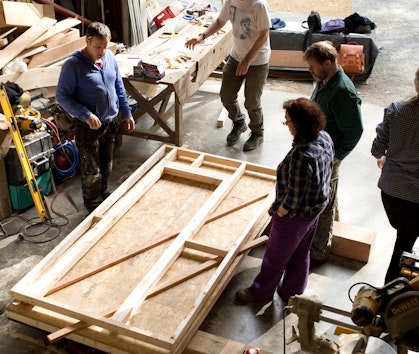
Natural building materials
At CAT we’ve been using natural building materials for many years, and there are many examples around the centre. We also run hands-on courses and workshops and sell many practical books.
Our page on low energy buildings talks about the embodied energy or life-cycle impact of building materials. These are ways of assessing the impacts in the extraction, manufacture, and transportation of materials.
Think about what will happen at the end of a building’s life. Try to choose materials and techniques that will make reuse or recycling easy. Many common building materials will eventually end up in landfill or an incinerator because they cannot be reused or recycled. In the UK, construction waste produced per person is more than double collected household waste!
Another important factor is the creation of healthy buildings. This is not just about indoor air-quality, but also thinking about the breathability of a building. Using materials that buffer humidity and don’t trap moisture is great for avoiding damp problems.
Natural building materials
A great way to address all of the issues raised above is to use natural materials such as timber, straw, hemp, earth, and more.
Some of these materials are from an abundant source, like earth, and are extremely reusable. Other natural materials can be regrown, and are therefore from a renewable source. They absorbed carbon dioxide as they grew, and using straw, hemp and similar materials as insulation will then store this carbon. This greatly reduces the carbon footprint of a building.
Many eco-building methods are accessible to amateur builders. For example, building with straw, hempcrete & timber-frame techniques are all methods that can be learned fairly easily and quickly.
What natural building materials could I use?
Wood is versatile and often beautiful as well. For sustainably-harvested timber, look for the FSC mark. At CAT we’ve avoided chemical treatment of timber whenever possible. The chemical treatment of timber has become almost standard practice in the UK, but it is very rarely necessary. To avoid timber decay use good quality, well-seasoned timber and ensure that the building design provides protection or ventilation of all timbers. Rot-producing fungi will only attack timber that remains damp over a sustained period, so any timber that will get wet must be able to dry out.
When you need a surface finish, look for natural paints and stains made from plant-based resins, oils and dyes. They will biodegrade on disposal, and little energy goes into their production.
Straw is a by-product of agricultural production and of low value. Building with bales is quick and easy. Hemp building generally uses a byproduct – the ‘shiv’, which is the inner core of the hemp stalk. Hemp is easy to grow, increases local biodiversity and needs little or no fertilisers. We used hempcrete in our WISE building, made by mixing hemp shiv with a lime-based binder.
Building with earth
Unfired earth has a very low carbon footprint because very little energy is needed to extract, transport and work it. Earth is not an insulating material, but is a great way to provide ‘thermal mass’ to buffer heat. This makes it a good alternative to concrete blocks or bricks for internal walls.
There are different ways of using earth in building, and most have a very long history. We’ve used rammed earth walls here at CAT, in our information centre and in WISE (the Wales Institute for Sustainable Education). We’ve also used compressed earth bricks to build a toilet block and as internal walls in WISE. Cob building uses a mixture of earth and straw and was traditionally used in the south-west of England and parts of Wales. Clay plasters can provide an original, natural finish to interior walls and ceilings.
Breathable construction
Broadly, breathability is the ability to buffer moisture – to soak it up and then release it. Most natural building materials are breathable, and you’ll need to ensure you don’t seal them up behind finishes that will trap moisture.
One example is using lime plasters and renders. Unlike cement, lime is breathable and so is a sympathetic finish or binder for natural materials. Lime bonds well to earth because it is also a soft and porous material. Earth and lime expand and contract at the same rate, so the lime finish will remain stable and well adhered. You can even remove, soak, remix and reuse old lime putty, plasters and renders. Lime finishes will set by gradually reabsorbing the carbon dioxide that was given off during production.
Further Information
See the related questions below for more details. CAT runs many short courses on the natural building techniques mentioned here. We also offer workshops to visiting groups.
Our online shop also stocks some books about natural building materials.
Finding eco-builders
The AECB promotes sustainable building and retrofit, and you can find eco-builders using their directory of members. Or see the Passivhaus Trust member listings. Another listing site for green builders is the Green Register.
Related Questions
What is breathability?This can be a confusing term for two reasons. Firstly because it refers to moisture not air and secondly because the exact physical processes which go on in a building are complicated (and still being researched). However the metaphor of breathing captures the important idea of continual movement. Moisture in itself might not matter, as long as it doesn’t take up permanent residence in your walls.
Broadly, breathability is the ability to buffer moisture – to soak it up and then release it – thus avoiding a situation where water vapour is retained by the fabric of a building. The technical term for this property is hygroscopic. Natural materials tend to be more hygroscopic than synthetic ones. The term “vapour permeable” also gets used in this context, referring to materials that allow water vapour to pass through at a certain rate.
A breathable construction will be made up of a gradation of vapour permeable materials, with the materials towards the inside being less vapour permeable than the materials towards the outside. A rule of thumb is that the material on the inside (warm side) should have five times the vapour resistance of the material on the outside (cold side). Without using a very high resistance material such as polyethylene or foil-backed board, this can be achieved with a suitable vapour-check layer on the warm side of the insulation. This layer slows down the passage of moisture to a safe level.
The construction also needs to be airtight on the inside to ensure the vapour-check layer works as intended. So it’s important to not put gaps in the vapour check layer for services (wires, etc), and instead have a thin space for these services between the vapour check and the internal finish (e.g. plasterboard). The final layer of external cladding might be waterproof (such as tiles) but there must be a ventilated gap between this and the sheathing board that actually completes the breathable construction.
In a UK-type climate the interior of a house usually has a higher relative humidity (RH) than the outside because it contains people exhaling, cooking, and washing. It’s a very general rule that, left to themselves, things will always migrate from an area of higher concentration to one of lower concentration, so there will be movement of water vapour towards the outside (or, to be more technical, the interior has a higher vapour pressure).
At times of high interior RH, water vapour will enter the walls, lowering the RH (both high and low RH cause problems and the ideal range is 40-60%). At times of lower interior RH, almost all of the water vapour will migrate back into the interior to be taken away by air currents. Any water vapour that might have managed to penetrate the wall deeply will be drawn out towards the exterior because of the lower permeability of the outer layers, so no harm done. Any water coming in from the outside will be unable to get very far as it is pushing through layers of decreasing permeability. The breathability of materials interacts with both temperature (which affects RH) and ventilation (one of whose functions is to carry away water vapour).
When hemp ‘shiv’ (the inner core of the hemp) is mixed with a lime-based binder it forms a durable, insulating, reworkable and natural insulation material. It’s suitable for new builds and for renovation projects. As well as stopping heat loss and absorbing sound, it is porous and so is breathable – regulating moisture.
The thermal conductivity (k-value) of hempcrete varies with the composition and density of the mix, but can be around around 0.06 to 0.11 W/m²K. This value makes it similar to straw bale walls in terms of insulation for a given thickness.
A timber frame construction could give the same insulation value with a thinner wall, but it would not have the ‘thermal mass’ that the hemp and lime wall has (the ability to absorb and store heat from both internal and external sources).
A breathable lime binder is necessary. Although less energy is involved in the manufacture of lime compared to cement, it still has quite a high embodied energy. However, in the case of hempcrete, the hemp sequesters carbon as it grows, offsetting the carbon emissions produced by manufacturing lime.
Hemp is easy to grow, increases local biodiversity and needs little or no fertilisers. Even intensively-grown hemp will sequester carbon, helping to offset that produced in manufacturing the lime. The microscopic holes in the hemp trap air so the dried hemp and lime mix is an insulator.
There are basically three different types of insulation material:
- Organic – those derived from natural vegetation or similar renewable sources, which tend to require a low energy use in manufacture (a low ‘embodied energy’). Examples are sheep’s wool, cellulose, cork, wood fibre, and hemp.
- Inorganic – derived from naturally occurring minerals which are non-renewable but plentiful at source. Likely to have a higher embodied energy than organic materials. Examples are mineral/glass fibre, perlite and vermiculite (from volcanic rock) and rigid foamed glass.
- Fossil organic – derived by chemical processes from fossilised vegetation (oil) – a finite resource. Fossil organic insulation materials such as expanded polystyrene and polyisocyanurate or phenolic foam are highly processed, resulting in a high embodied energy.
Which is best?
If possible it is better to choose insulation materials that have not been heavily processed as this will reduce the carbon footprint and environmental impact of your home. But it is far better to install cheaper inorganic or fossil organic materials with the right physical properties and a low thermal conductivity than to install nothing at all.
In many cases, organic insulation material can be applied instead of inorganic or fossil organic, but there are exceptions. For example, there is not an organic insulation material suitable for cavity wall insulation.
Think also about the ease of installation. Loose fill insulation is quick to put in in lofts, but cannot be DIY installed in anything other than a flat place. Rigid boards and batts will come in certain sizes, but need to be cut to shape if you have some unusual spaces. Some materials can be cut with a knife, but a few will need a saw. Some mineral wool now comes in a thin foil or plastic wrap, to protect from the fibres. You should still wear a face mask when installing any type of installation, as small fibres of any kind are best not inhaled.
A manufactured insulation material comes with a certificate to show its insulation value and how it satisfies standards such as fire safety. If the material is installed in the way laid out in the certificate, it will be accepted by Building Control. Therefore, for many that’s a much easier option.
If you want to use sheep’s wool as insulation in a DIY way, it’s basically up to you to show Building Control that your approach will meet those required standards. This will involve some extra work and time. Detailed documents relating to building regulations & building control are available on the Planning Portal.
One key thing is that the borax treatment mentioned below is only available to professionals, so you may need to pay someone to do this treatment for you. You’d need to compare the costs of doing that to buying a pretreated natural insulation product instead.
Meeting insulation requirements under Part L of the Building Regulations is technically possible as sheep’s wool has a similar thermal performance to most other fibrous insulation materials. Provided there is a similar thickness the requirement should therefore be met, but you’ll need to demonstrate this. Installing more than the minimum thickness required is a good start.
Here at CAT we used sheep’s wool to insulate our information centre back in 2000. The wool was from the British Wool Marketing Board and had already been scoured and carded. It was delivered to us in hanks and we installed it in the wall cavity at a density of around 25kg per cubic metre.
Carded wool has teased and thinned out. This follows scouring, which is a process of washing the wool three or four times to clean it and remove the lanolin. Some argue that washing removes the wool’s natural grease that protects it from insects, and if you don’t wash the wool you don’t need borax. However, research has shown that lanolin is a fire hazard, and unwashed sheep’s wool is a potential fire risk.
The wool was sprayed thoroughly with a borax solution and installed in a sealed cavity by our eco-building contractors. Borax is a salt based solution derived from the mineral salt, boron. It provides increased resistance to fire, and is an insecticide – stopping moths and other insects from infesting the wool. We used a 10:1 mix of water and borax powder.
Note that as mentioned above, borax (and other boron products) are now only available to professionals, so you might need to pay someone with suitable experience (for example in timber treatment) to do this for you. Borax in powder form is available in some places, such as for professional timber treatment. Note that while a ‘borax substitute’ is widely available to the public for cleaning use, that is sodium sesquicarbonate and won’t have an effect as insecticide.
We haven’t experienced any problems, but we have heard of sheep’s wool in lofts becoming infested with moths, possibly because it wasn’t sprayed well (or at all) with borax. Correct treatment is vital, as addressing any problems would be disruptive and messy. Infested insulation may all have to be removed.
Some early batches of commercial sheep’s wool (going back many years) were not treated with a boron based treatment. Instead they had some sort of ‘diatomaceous earth’ treatment, which turned out to be insufficient to prevent moth larvae infestation.
Wool is not suitable for a conventional brick & block cavity, but is fine in a breathable construction. At CAT we used it in a timber panel type of construction that allows moisture to pass through rather than becoming trapped. Sheep’s wool is very ‘hygroscopic’, which means it’s able to absorb moisture in humid conditions, and then release it later.
To make rammed earth walls, loose, moist subsoil is compacted in thin layers between shuttering or formwork. The shuttering can be moved along or upwards as the wall is constructed. Mechanical compaction forces clay molecules to bond with the aggregate (a physical rather than a chemical bond), giving the wall its strength. Compaction is vigourous work and a powered hand-held tamper makes a big difference to the construction process. The pneumatic rammer used in the WISE rammed earth wall construction was a Trelawny VL compactor.
Particle size and grading, moisture content, and clay content are all critical to the performance of the finished wall. Over a period of time, perhaps up to two years, a rammed earth wall will dry out and become as durable as sandstone, as long as it is waterproofed top and bottom.
At CAT we have used rammed earth only for internal walls, where it provides useful thermal mass. In the UK climate, earth by itself is not a good material for external walls. It’s poor as insulation and will degrade in our weather conditions. Some techniques add cement to make ‘stabilised earth’, but this eats into the environmental benefits. Tim Coleridge, Programme Leader of one of our MSc courses, says:
“A word of caution regarding the use of cement stabilised rammed earth. Even quite low proportions of cement added to an earth mix, e.g. 8-10%, would be similar to the cement content as a standard lightweight concrete block. So, to maximise the benefit of rammed earth a low-impact building material with low embodied energy and low embodied carbon should be designed without added cement, un-stabilised. Building codes vary in this regard, e.g. in Australia you’ll find the rammed earth building code requires added cement, effectively turning it into weak concrete in earthy colours (from our perspective).”
At CAT we avoid using cement-based mortar, render, concrete and blocks – mainly as a way to reduce embodied energy and carbon emissions. In many cases, cement materials are over-specified and can be replaced with lower impact materials. We have used lime-based render, mortar and concrete in a number of projects, as well as clay plasters. Instead of concrete block construction we’ve built with unfired earth, hempcrete, straw or other materials.
About half of the carbon dioxide (CO2) emissions from cement production are given off by a chemical reaction when limestone is heated to create cement. Most of the remaining CO2 emissions are from the fossil fuel used to fire cement kilns to high temperatures.
In the production of lime products, CO2 is still given off from a chemical reaction in the kiln. However, unlike cement, pure lime products reabsorb all of that CO2 as they dry out and harden over a number of years. A practical advantage of this slow setting is that it can usually be re-worked up to 24 hours after application (unlike cement or gypsum). It can also self-repair any small cracks that appear immediately after applying.
A hydraulic lime made from limestone with certain impurities will give a quick chemical set similar to cement, followed by slow carbonation. That process still reabsorbs a large proportion of the CO2 from the chemical reaction during manufacture. Hydraulic lime is useful as a binder in hempcrete construction, or in foundations.
Lime can absorb and hold moisture in periods of high humidity, and then release this moisture when the humidity levels drop. This helps to prevent condensation in interior spaces (the main cause of moulds and fungi).
Lime has advantages with conventional masonry construction as well. Bricks and stones joined with lime based mortar or render will separate and clean up, ready for re-use. It’s very difficult to separate bricks joined with cement mortar, so their only practical reuse is as hardcore.
Where the greater strength of a cement-based material is needed, the impact can be reduced by using an alternative such as pulverised fuel ash (PFA) or GGBFS (ground granulated blast furnace slag) to replace a proportion of cement used. GGBFS is a byproduct of the steel and iron industry, and PFA is waste from power stations.
The properties of lime must be well understood – it cannot be used in exactly the same way as cement. Accurate batching is critical, as is minimal and carefully administered water content. The mixing time is longer than for cement (10-15 minutes), but overmixing can turn the whole thing to jelly. ‘Limecrete’ must be protected from drying out too quickly (damp hessian is a favoured covering material) and it is essential to protect from frost for the first week or so.
Foundations are designed to spread the load of the building over a wide area to prevent sinkage. The base needs to be below the frost line (usually 750mm), free of organic matter that could rot, and away from trees.
The environmental impact of concrete use can be minimized by installing pad or strip foundations and using recycled rubble as general fill. The cement in concrete can be avoided by using hydraulic lime as the binder. Adding large aggregate to bulk out the concrete saves cement. Recycled aggregate, such as crushed waste concrete, can be reused with hardly any impact on strength. You can substitute up to 50% of the cement with pulverised fuel ash (PFA), a waste from power stations, or with GGBFS (ground granulated blast furnace slag), a byproduct of the steel and iron industry.
CAT ecobuilding experts have given the following preference list for foundations (from most to least preferable). You could also seek advice from a local eco-builder or architect by looking through the AECB listings or the Green Register.
Masonry construction:
- Local stone foundation wall; DPCs/membranes of recycled polythene or bitumen; land drains around the house perimeter; minimise thermal bridging between foundations and the ground floor by using edge insulation.
- Second-hand bricks, sand/lime blocks or dense concrete blocks made with secondary aggregate, laid in a lime or weak cement mortar onto the smallest concrete strip necessary. Limecrete made from hydraulic lime and ballast, possible with additional pozzlan (setting) material.
- Concrete blocks made from new aggregate, or new bricks, laid onto the smallest concrete strip necessary.
- Trench-fill or reinforced concrete slab made from new aggregate. Short piles with reinforced concrete ground beams.
Timber construction:
- Timber (ground) beams spanning between timber piles or recycled brick piers on compacted re-used rubble. DPCs and membranes of recycled polythene or bitumen or slate.
- Piers as above on minimal concrete foundation. Posts set directly on a minimal concrete pad or short piles.
- Strip foundations and plinth wall as for masonry construction.
- Trench-fill or reinforced concrete slab made from new aggregate, unless ground conditions dictate. Short piles with reinforced concrete ground beam.
Here are some options for floor construction from CAT’s eco-building experts.
A ground floor could be either of these:
- A suspended, well-insulated timber floor of homegrown soft or hardwood joists and floorboards. Good draught-proofing of the floor and ventilation of the underspace are vital. The underfloor space sealed with a recycled polythene membrane and covered in local granular fill or recycled aggregate.
- A solid limecrete floor using recycled aggregate, laid on insulation. Lime can be used to stabilise earth or hemp as a floor base and finish, but should not be covered with an impermeable material (such as linoleum). A damp-proof membrane of polythene or bitumen.
These are in preference to concrete (joists and slab, with plastic foam insulation) or chipboard (above concrete slab, etc).
For an intermediate floor, the first preference is for homegrown soft or hardwood tongue-and-groove timber floorboards on homegrown softwood joists with timber lath & lime plaster or plasterboard underlining. The second preference is for a similar method but with plywood board or OSB (oriented strand board) floor. Either is preferable to a concrete beam and block floor or chipboard.
Timber flooring is sustainable as long as new trees are planted to replace those that are used. The best guide at present is the FSC certification mark, which shows that the wood has been sustainably harvested. Most flooring is of hardwood (from deciduous trees), but some ‘softwood’ (from evergreens) can be more durable than some hardwood, so could be suitable for flooring.
Another sustainable option is reclaimed timber flooring, which could come from old schools, chapels, etc. You could look for local suppliers of salvaged/reclaimed materials, or use websites such as www.salvo.co.uk or www.communitywoodrecycling.org.uk
In their natural cycle trees absorb carbon dioxide during their lifetime and this is released as the wood rots away (or is burnt). By using wood in buildings we lock up this carbon and prevent it from re-entering the atmosphere.
Carpets are hugely popular in the UK, but can cause problems. They provide an ideal home for dust mites, which can trigger allergies such as asthma (some carpets are treated with pesticides to try and prevent this). The mix of materials makes them difficult to recycle, and if incinerated they give off toxic dioxins and furans.
Carpets with the least impact are made of wool, with hessian backing and felt underlay – but these may still have involved toxic chemicals in manufacture.
For an eco-friendly floor, consider sustainable timber (look for the FSC logo) or a solid floor with ceramic or cork tiles.
Ceramic tiles, stone or slate are good at absorbing the sun’s heat during the day and releasing it at night, so are a useful part of passive solar design (for example in an unheated conservatory).
Engineered wood flooring is made up of layers at right angles – similar to plywood. Less glue is needed than with chipboard or MDF, so the impact is lower.
Note that laminated wood (thin layers of timber) is different to ‘laminate flooring’ – which is plastic finished with a photograph of wood grain. Besides the higher impact in manufacturing, these tend to fade and scratch, and so need regular replacement – whereas a good timber floor should last for the life of the home.
Bamboo is a quick growing plant and as long as (as with any wood) new plants are grown to replace those harvested, it is a sustainable material. However, transport impacts will of course be much higher than with more local timber. It is often treated with preservatives so check before buying.
For added comfort, use rugs or mats made from natural fibres such as paper fibre, Rattan (palm), Seagrass (grown in Chinese paddy fields), Sisal (from the agave plant of Brazil and East Africa), Coir (coconut husk fibre), Hemp or Jute (herbaceous annual from Bangladesh and India). Although mostly imported, these natural materials can be sustainably produced.
Cork is harvested from the bark of the Mediterranean cork oak without killing the tree so is a sustainable, renewable source. Without support, cork forests will be cut down, which will have a big impact on wildlife and biodiversity. However, some cork products are pre-finished with a polyurethane or PVC coating – look for unsealed cork products. There are oil based treatments for cork flooring such as Osmo Polyx-Oil which increase the floor wear and make it stain resistant and easy to clean.
Illegal child labour is widespread in the production of hand-knotted rugs from India, Pakistan and Nepal. Many are victims of bonded or forced child labour – a modern form of slavery. If a rug or carpet displays the ‘Goodweave‘ logo you can be sure that illegal child labour was not used, and that adult weavers were paid at least the country’s minimum wage.
Linoleum is an eco-friendly alternative to vinyl (PVC) made from vegetable linseed and natural resin spread onto hessian or jute fabric and treated with water-based acrylic ‘dispersion’ paint. Linoneum (or Marmoleum) is made from natural materials and is resistant to fats and oils, sound-absorbent, anti-static, light resistant, and has very low flammability and a natural anti-bacterial effect.
The manufacture of PVC (i.e. for vinyl flooring) causes lots of environmental problems, including the release of asbestos and mercury. High levels of dioxins and other organochlorines are found around PVC plants – these pollutants have been linked with cancer, immune system damage and hormone disruption.
The people involved in designing several buildings here at CAT gave the ranking below for roofing options.
Pitched roof
In addition to the preferences below, now that solar PV panels are so much cheaper than just a few years back, a south-ish facing section of roof could have solar panels integrated in as the roof finish. You’d then make a saving on roof tiles for the area covered. See our page on solar PV for a related question about the ventilation needed for a roof-integrated PV array, as well as more general info.
- Salvaged tiles or slates (the ideal form of reuse, involving minimal processing), or oak or cedar shingles from a sustainable source (FSC certification or equivalent), or locally sourced thatch of reed or straw. For timber or thatch, a house (or terrace of up to three) will need to be a few metres from its nearest neighbour to meet fire regulations.
- Next choice of durable timber boarding, such as larch, or new UK slates. Another more recent option that would probably fit in alongside these is UK-made recycled plastic slates, such as the Ecoslate.
- Otherwise, various conventional options: clay or concrete tiles, imported slates, metal, or bitumen fibre. We used a thin Uginox stainless steel sheet roofing on parts of the recent WISE building – as although metal takes more energy to make, the steel gives a long service life in the wet Welsh weather and can eventually be reclaimed and reused, or is 100% recyclable.
- The final and least preferable option would be fibre-cement, corrugated sheet, or wood from a non-sustainable (not certified) source.
Flat or low pitch roof
Again listed in order of environmental preference:
- A single-layer natural rubber or EPDM membrane, loose-laid and fixed only around the edges (the minimal fixing prevents cracks & leaking). EPDM is a synthetic rubber/elastomer which is completely recyclable. A covering of earth with turf or sedum and other hardy planting will ballast the membrane from winds. Loose-laid EPDM can be re-used and is a preferable material to bitumen or PVC. The benefits of a green roof will compensate for the use of high impact materials. About 30 square metres of green roof should add the same amount of oxygen to the atmosphere as one person uses.
- Tin-coated or plain stainless steel (as with pitched roofs)
- Other metal sheet roofs, or bitumen felt
- PVC membrane (due to environmental problems associated with PVC manufacture).
Flashings
The impervious material used to close off gaps at junctions of roof coverings and other features. Of the variety of materials available, the most environmentally friendly options are stainless steel and EPDM (a synthetic rubber membrane). Other metals such as lead, copper, zinc (some question over recyclability) and aluminium are widely used however these all have higher embodied energy than stainless steel. Bitumen reinforced with aluminium foil should be avoided if possible, because it isn’t durable and can be cause damage at disposal.
Guttering preferences
- Wooden guttering, lined with EPDM, with metal downpipes (readily reused or recycled).
- Galvanised steel, zinc, copper or cast iron.
- Aluminium.
- PVC.
Related Pages
Related events

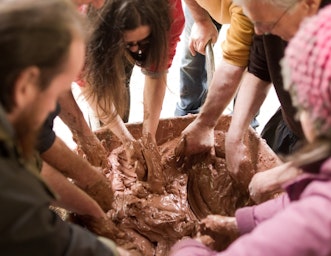
Cob Building
9th August 2025
Building with Earth and Natural Fibres
13th September 2025
Eco Refurbishment
29th September 2025Study at CAT: Our Postgraduate Courses
Related news
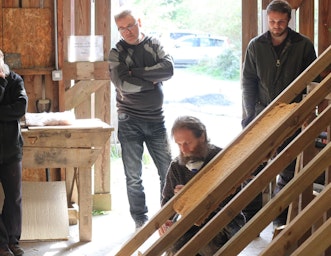
CAT stories – Nick Parsons and Mike Russell
29th January 2025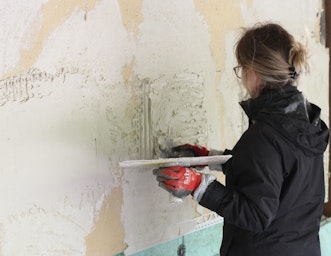
Ready for retrofit
29th January 2025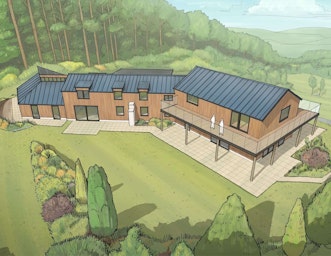
Hawkland — eco business takes flight
29th January 2025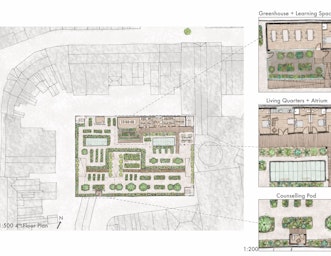
Designs for Life
23rd May 2024Related Books
WANT TO LEARN MORE?
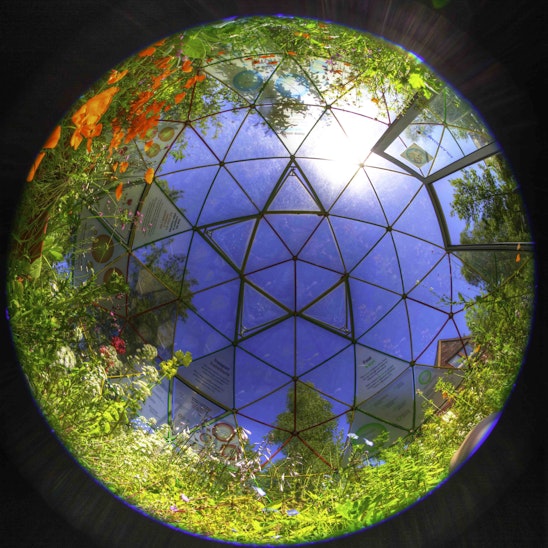
Did you know we are a Charity?
If you have found our Free Information Service useful, why not read more about ways you can support CAT, or make a donation.
Email Sign Up
Keep up to date with all the latest activities, events and online resources by signing up to our emails and following us on social media. And if you'd like to get involved and support our work, we'd love to welcome you as a CAT member.

